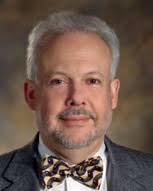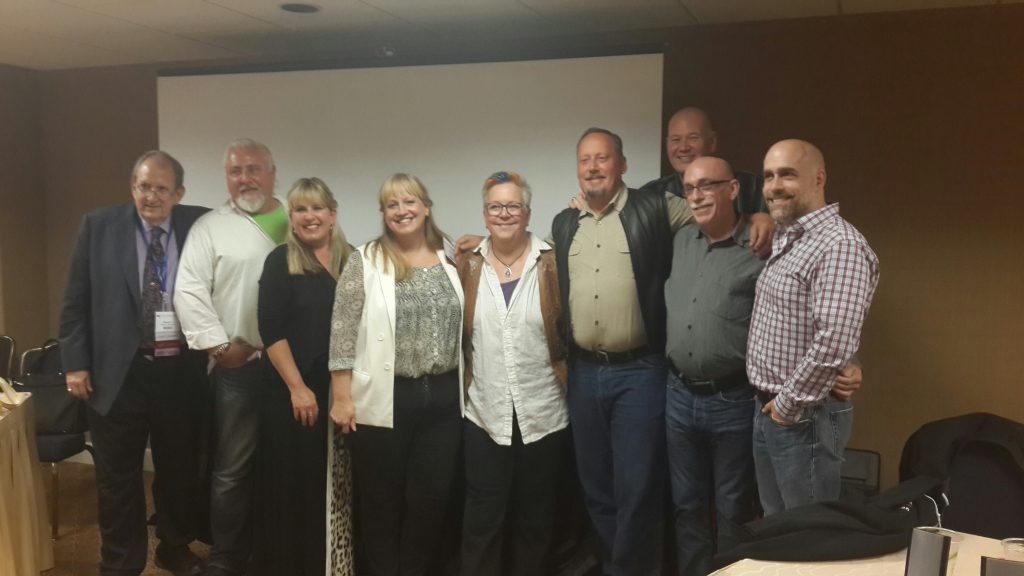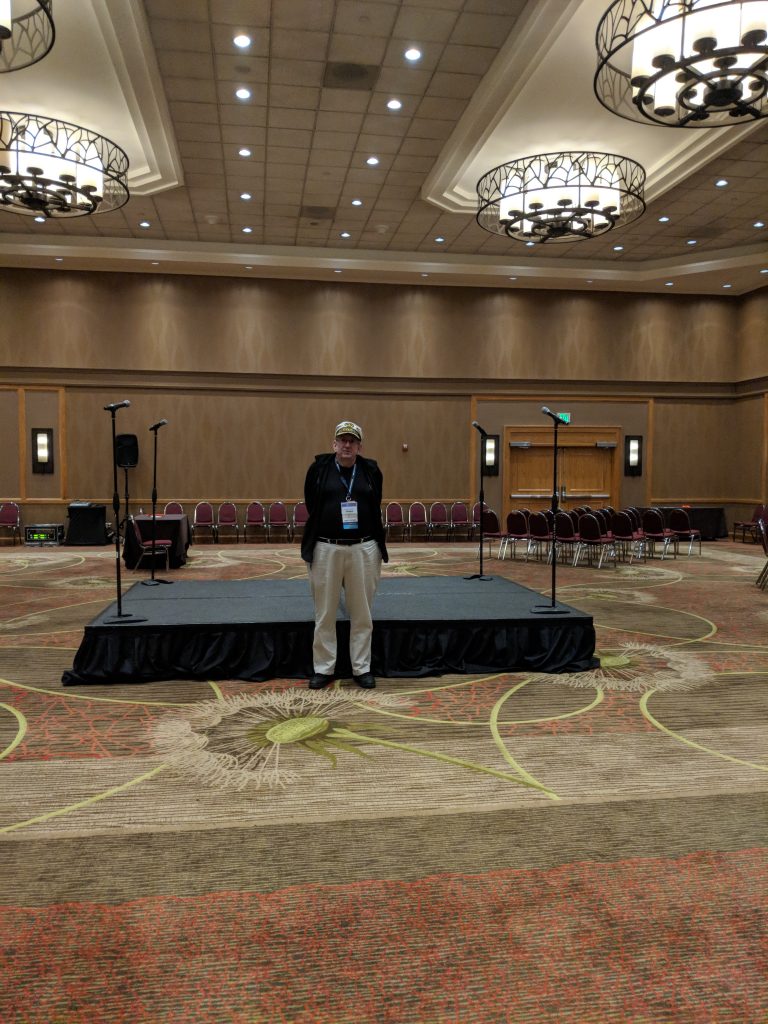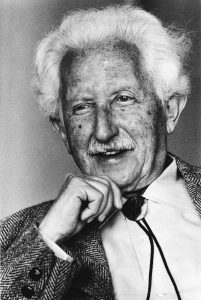Foreword:
At the end of the 1980’s, the nascent world of open, above ground BDSM was facing very hard times. Pansexual BDSM groups had come aboveground shortly after the 1969 Stonewall Riots, and local groups had burgeoned in major cities during the early 1970s. The Leathersex communities’ titleholder events had become national conventions in the 1980s, and in 1983, david stein’s iconic “Safe, Sane and Consensual” campaign had gone viral among the gay and pansexual BDSM communities.
But as the decade drew to a close, Safe Sane and Consensual looked like a PR campaign, not reality. The HIV/AIDS pandemic ravaged the Gay and Altsex communities, putting an end to the illusion of ‘Safe Sex”. The American Psychiatric Association came out with the Diagnostic and Statistical Manual (DSM-IV). Although it had completed the delisting of homosexuality begun in 1974, no such revision included consensual altsex behaviors, all of which were psychopathology in the new manual. Kink was officially not ‘sane.’ And across the Atlantic Ocean in The United Kingdom, Scotland Yard arrested several dozen Leathermen in a sting operation and charged them with assaulting their submissives. When the Leathermen protested that the assaults were consensual behaviors, the submissives were charged as accessories in their own ‘victimization;’ English law provided no right to consent to assault. All would eventually serve three years in prison. American activists held their breath that judicial conservatives appointed by Ronald Regan might import this thinking to the US. You might consent to kink behavior, but that carried no guarantee you would be protected under the law!

This article details how the contribution of one man; Charles A Moser, MD, PhD, challenged the clinical assumptions that had pathologized consensual kinky behavior for over a century before he started working to overturn them. It is a story of the struggle to make psychiatric diagnosis abandon conventional and uncritical thinking and garden variety politics, for diagnosis based upon scientific evidence, logic, and thorough observation. Today, the most recent revision of the psychiatric manual regards a much wider variety of sexual expression as potentially healthy than in the 1980s because of Dr Moser’s work, which first saw fruition in the Diagnostic and Statistical Manuals 5th major revision in 2013, but continues as consensual kinks are delisted from the World Health Organization’s International Classification of Diseases (ICD-11) as it is individually modified and adopted by the United Nations 193 member nations. Charles Moser, PhD, MD is not recognized for this contribution by the American Psychiatric Association, but his work established the intellectual foundation for the DSM changes and inspired and international movement that is manifesting in the ICD-11 revisions.
The Context of Challenging the DSM:
“Here we must beware the game of name-calling hidden in otherwise decent but indemonstrable concepts favored by psychoanalysis, concepts such as narcissism, deneutralized libido, and prepsychotic masquerading as normal. None of these terms has been defined clearly enough so that observers can agree when evaluating a live person. So I avoid them. I can only say that, within the highly selective sample that my informants present, there is no one who is psychotic, prepsychotic, or latently psychotic by the standards that clinicians accept, for example having hallucinations, delusions, inexplicable or bizarre behavior, or major pathology of mood. And these people, were one to try to apply character diagnosis to them, are as varied as I expect are the readers of this book. Most of my informants are stable in employment; most are college graduates or beyond, lively in conversation, with a good sense of humor, up-to-date on politics and world events, and not more or less depressed than my social acquaintances.” — Robert J Stoller, MD, in Pain & Passion: A Psychoanalyst Explores the World of S&M (1991) pp 19. (The emphasis is mine, the italics, Stoller’s)
Social change is very rarely the product of any single individual. Not Frederick Douglas, Mohandas Gandhi, nor Martin Luther, great though their individual contributions may be, accomplished their social changes in a vacuum. So it is with de-pathologizing kinky behavior. Robert Stoller sums up the problems of destigmatizing kink in his first chapter of his book. Having called sadomasochism a perversion, he must claw back the impression that his study is about a bunch of crazies. At the time of its writing, his study of the world of commercial sadomasochism was three years ahead of the first representative sample study of American sexual behavior, The National Sex and Social Life Survey, which, to get funding through Congress during the George Herbert Walker Bush administration, pointedly declined to ask a single question about kink. Stoller’s conclusion above presages the first such sample that did ask about kink in any Western country by 17 years. This is the magnitude of the challenge that Charles A Moser took on when he conducted the first self-selected sample of American sadomasochists, and eventually decided to undertake a thorough criticism of the psychiatric diagnostic system as it related to consensual kink.
Charles A Moser, MD, PhD, did the research and academic writing that made diagnostic change possible. His research on kink and his contribution of over 100 scholarly articles over 45 years, most on alternative sexualities, created an evidence-based conversation in psychiatry that coincided with the social changes that have made de-pathologizing kink an intellectually credible effort. His bibliography can be found here: https://docx2.com/charles-moser-phd-md/ The links all avoid paywalls and I have employed them where possible so that you can read what Charles wrote.
To understand Charles intellectual contribution, it is necessary to describe the state of psychiatric thinking that prevailed at the end of the twentieth century as he began publishing his criticism. That entails looking at the American Psychiatric Association’s thinking and practice in revising their diagnostic manuals. In the late 1970s as psychoanalysis began to loosen its influence over American psychiatry, the American Psychiatric Association undertook its first major revision of the DSM. Before 1980, the manual was a plagued by disagreements over construct validity and there was poor agreement among clinicians about the diagnoses as Stoller emphasized in the above quote. The previous diagnoses might not be wrong, but neither were they agreed upon nor testable. The strength of the changes in the 1980 DSM revision is that diagnoses had greatly improved inter-rater reliability and were described in clearer symptomatic terms, albeit at somewhat decreased emphasis upon their underlying meaning and contexts. To destigmatize them somewhat, ‘Sexual Deviations’ were re-labeled ‘paraphilias’, a Latin/Greek chimera meaning ‘unusual loves.’ In 1980, no one was complaining that consensual paraphilias such as sexual sadism, sexual masochism, transvestism, and fetishism were stigmatized but the DSM-III did respond to intense pressure mounting since the late 1950’s to stop including homosexuality as a sexual deviation because that was so highly stigmatizing and not well grounded in the best science. That story is told in more detail here: https://elephantinthehottub.com/2017/06. Since 1980, the American Psychiatric Association had delisted homosexuality but asserted it could feel confident in their classifications of the on the grounds that they were clearly described symptoms that could be reliably coded.
All that was about to change in the wake of Stonewall, as kink practitioners started to come above ground. In 1972, Pat Bond and Terry Kolb took the Till Eulenspiegel Society (TES) out of Bond’s small apartment into the basement of the first openly gay friendly church in the country, publicizing their meetings in Screw and The East Village Other, although to do so, he had to change his original name, The Masochists Liberation Front to the name of an obscure figure from German folklore in order for even the underground press to run his meeting announcements. On the West Coast in 1974, Cynthia Slater founded the Society of Janus (SOJ) in San Francisco. These pioneers were testing the theory that kinky folk would have enough in common regardless of their specific sexual interests that they would get together for social meetings and durable clubs could be formed. This set the stage for Charles Moser to gather data on people practicing sadomasochism and make evidence-informed arguments about them.
Charles graduated from the University of Washington School of Social Work in 1975, just as these social kink organizations started to form. He was aware of them because of the sexual diversity of his initial social work placement and later private practice, and he enrolled in the Institute for Advanced Study of Human Sexuality (IASHS) because it was a unique and convenient place to pursue additional training in human sexuality, a much-neglected topic in post-graduate mental health training. In 1979, Charles completed his doctoral dissertation on a sample of self-described sadomasochists for his PhD at the IASHS, in San Fransisco. The sample for Charles study was drawn from contact magazines and from volunteers from TES and SOJ. In 1984, with the famous sociologist of sexual communities M S Wienberg and with C J Williams, he published his first academic paper on kink in the journal Social Problems in which they noted that their sample of sadomasochists did not conform well to the medical definitions of sexual sadists and masochists. Instead, they argued that sadomasochism consisted of dominance and submission, role play, consensuality, a sexual context, and mutual agreement by participants to call what they were doing ‘S&M’. That paper can be found here: https://docx2.com/wp-content/uploads/The-Social-Constituents-of-Sadomasochism.pdf. This paper was published very shortly after the gay submissive david stein coined the slogan “Safe, Sane and Consensual’ for New York City’s Gay Male S/M Activists (GMSMA) in 1983 to address widespread public concerns that kink was dangerous behavior performed by crazy people, a very legitimate reading of the prevailing psychiatric definitions. At that time, scarcely any data had been collected about kink practitioners and there was little basis for scientifically disputing negative public perceptions or psychiatric diagnoses.
Charles went on to publish the conclusions of the first self-selected sample studies of American kink practitioners. Prior to his work, there was only one sociological study of members of a kinky community, by Andreas Spengler, in Germany https://link.springer.com/article/10.1007/BF01541150 . Charles challenged prevailing notions from Spengler’s German data that the only women who participated in kink lifestyles were sex workers, and that most of the men were gay. And Moser’s data mirrored those of his urban sexology practice in the Bay Area in the midst of the developing HIV crisis. Under these pressures, Charles left social work to take medical training to amplify his ability to serve a much more diverse sexual community than anyone had anticipated when he had completed grad school 8 years previously. Having already established a practice as a sex therapist, Charles correctly foresaw that he would need all the legitimacy he could get to best serve his outsider clientele, even though he claims not to have foreseen the approaching tsunami of financial services colonization of mental health. In 1991 Charles took the plunge into medical training. Since his completion of his medical residency in 1994, Charles has maintained a medical practice as an internist and primary care physician in San Francisco.
As of 1997, about when I first met Charles at AASECT Charles had yet to publish on the weaknesses of the DSMs and the weaknesses in the American Psychiatric Associations case for pathologizing consensual kinks. In his essay for a collection of the personal journeys of professional Sexologists, How I got Into Sex https://www.amazon.com/How-Got-into-Sex-Criminologists/dp/1573921157, Charles described becoming a leading expert on sadomasochism, the Director of Research at IASHS, and had a thriving practice as an internist serving a sexually diverse community without having decided to commit his knowledge to challenging Krafft-Ebing’s orthodoxy of 115 years earlier. Several changes mobilized him.
In 1997, NCSF was founded conjointly by the TES, SOJ, GMSMA, and the National Leather Association. Two years later, Charles served as a consultant to NCSF. Among its missions, NCSF sought to destigmatize consensual kink. Charles was a natural fit with NCSF’s desire to do that using scientific argument and evidence.
In 2000, The American Psychiatric Association issued an update of their DSM-IV, the DSM -IVTR, which left most of their diagnostic categories unchanged, including those covering the paraphilias, thus dispelling hopes they would make these diagnoses less pathologizing without increased pressure from outside advocacy.
In 2001, the first representative sample studies began to emerge suggesting that many psychiatric assumptions about sexual variance were overly pathologizing kink. Charles’ study found most kinksters were happy with their sexual interests, a finding inconsistent with the American Psychiatric Association’s stance. Although those he studied were not sick or depraved, they constituted a sample of kinky volunteers. Like Stoller’s informants, it was not possible to know if they were representative of the larger population of Americans engaged in kinky behaviors. Following J Richters et al (2008) https://onlinelibrary.wiley.com/doi/abs/10.1111/j.1743-6109.2008.00795.x as series of studies explicitly evaluated the mental health of kinky subjects using the Neuroticism Scale of The Big Five Personality scale. Other studies were critical of the models pathologizing kink (Cross and Matheson (2006) to be found in https://www.amazon.com/Sadomasochism-Powerful-Pleasures-Peggy-Kleinplatz-ebook/dp/B00HRU95X4. The first representative sample study of diverse sexual behaviors in the United States was published in 2017, but did not examine personality or mental health.
Taking over from the initial efforts of Guy Baldwin and Race Bannon, The National Coalition for Sexual Freedom had relaunched the DSM project in the late 2000s to influence the DSM review process, and in the years close to the 2013 release of DSM – 5, NCSF had talked directly with the Paraphilias Committee members about the accumulating data that the mental health of kink communities, in so far as it could be known through social surveys, looked pretty similar to that of the general population. The Paraphilias Committee had done a thorough review of the academic literature and was well aware of these data even as the advocacy community presented them. But so too were the Paraphilia Committee members aware of the many other social actors who presented alternate points of view that the public hoped APA would accommodate. For all the disclosure, there is an irreducible opacity in just how much the volume of these efforts influenced the final product. You will just have to take my word when I suggest that the tremendous body of work the Charles Moser published played a critical role in altering the context for these discussions. But here is the evidence from Charles own writings. Don’t take my word for it, take his!
Charles and the DSM:
The summary that follows highlights Charles Moser’s arguments against the paraphilia sections of the DSM. In the period between the release of DSM-IVTR in 2000, and the May 2013 release of DSM – 5 publishing date, Charles wrote 16 articles on other topics, about half of which targeted problems with other sections of the manual, including those covering sexual disorders, the proposed diagnoses of hypersexuality/compulsive sexual behavior and sex addiction which eventually were not included in DSM – 5, and on gender diagnoses. This essay focuses of the paraphilia category itself because of its centrality to the experience of all kinky people, but these other diagnostic criticisms are important to many kinksters because communities overlap, and much BDSM involves gender play.
In 2001, Charles began his direct attack on the DSM in Paraphilia: A Critique of a Confused Concept. http://tempik.webzdarma.cz/literatura/parmoser/. In it he thoroughly deconstructed the assumptions behind the concept of paraphilia as represented in the DSM. The core of his argument was that medicine and sexology knew so little about the etiology of heterosexual, homosexual, or variant sexual interests that there was no basis for handling these sexual interests differently in the manual. Sexual interests were some more frequent than others, but extremely variable throughout the contemporary human population and throughout history, with no intrinsic basis for declaring some troublesome and others benign even though some more directly led to reproductive consequences. This was tacitly acknowledged by the APA when the DSM stopped pathologizing homosexuality, which had originally been classified with the perversions by Krafft-Ebing precisely because of its inevitable consequences on reproduction. If homosexuality was no longer a disease, why then were less common or less popular sexual interests still pathologized?
Charles answered his own question by analyzing the process and dynamics of how clinicians define variant sexual interests as mental disorders. This process relies on the subjective opinions of clinicians. No matter how ‘scientific’ the procedure for comparing the agreement between diagnosticians might be, calling for them to make a subjective estimate of pathology that was lacking a solid basis in scientific evidence was faulty science. The current nosology reflected heterosexual bias and privileged social assumptions of normality on a conventionalist basis.
When it came to science, the paraphilia category had no clothes. Although back in 1980, John Money had appropriated Wilhem Stekel’s language ‘paraphilia’ or ‘strange love’, in the chimerical contraction of Latin and Greek, to rescue the diagnoses from the obvious stigma of the previous term; “sexual deviation” — the language in DSM’s I and II — the paraphilia language had become stigmatizing due to the inherent unscientific assumptions of the psychiatric profession itself! There was no good science linking the paraphilias together such that they inevitably co-occurred or profited from the same treatment, and it was unclear, when such interests were presented as ‘ego-dystonic’ or unwanted that the reasons were intrinsic to the preferences, rather than real or imagined discrimination based upon social stigma. In fact, Moser argued, it was unclear that the sexual variations were diseases at all. By showing that the diagnostic manual reserved to the clinicians’ subjective opinions the critical diagnostic question of whether a sexual interest was a problem, Charles had APA in a trap. With the recognition that all such decisions were subjective in their application, they lacked a scientific basis. Yet what is the purpose of a diagnostic category if it does not reserve to the clinician the basis for conferring a diagnosis on the basis of their expert knowledge as professionals?
Charles proposed an alternative diagnosis, Sexual Interest Disorder, which had the advantages of not being biased in favor of heterosexuality, and making few unsubstantiated assumptions about content, causality, or treatment. In 2002, in support of Richard Greene, one of the principal APA members involved in de-pathologizing homosexuality, Charles attacked APA claim that its paraphilia diagnoses were empirically based and culturally sensitive. In fact, behaviors that the DSM-IVTR pathologized were culturally accepted in other societies and times, and, like Green’s argument about pedophilia, didn’t meet the scientific requirement for being called a mental disorder. What APA really meant by being evidence-based was that a behavior could be coded reliably, not that it proved a disease process was present. Worse yet, by labeling such desire the disorder, the clinician was distracted from finding the true cause of the presenting problem, which might have little to do with the paraphilic behavior. In that way, lifestyle choices, impulse problems, relationship conflict or affect regulation were ignored as possible causes of distress in favor of the notorious symptoms. In addition, as with pedophilia, psychiatry was encouraging confusion about the difference between criminal conduct and mental disorder. Despite the advantages of parsimony and greatly reduced bias and stigma, the Sexual Interest Disorder saw no discussion in the DSM – 5 review process.
In 2005, Moser and Peggy Kleinplatz took the diagnostic criteria for the paraphilias and applied them to heterosexuality. As described in the DSM, heterosexuality would be a mental disorder using these criteria. It “1) persisted over a period of six months or more with intense sexually arousing fantasies interest or behaviors involving sex with an adult of the other sex, and 2) was acted upon with a non-consenting person or fantasies, urges or sexual behavior had caused clinically significant distress or impairment in social, occupational, or other important areas of functioning.” The authors admit that the DSM provides some differentiation for the paraphilias in that these interests are different from non-pathological uses of sexual interests and behaviors, but provides no criteria whatsoever, let alone research-based criteria for deciding which are pathological and which are not. Moser and Kleinplatz conclude that diagnostic criteria that could pathologize everybody hardly constitute the basis for a sound diagnostic system. https://docx2.com/wp-content/uploads/Does-heterosexuality-belong-in-the-DSM_.pdf
In 2006, Moser and Kieinplatz commandeered an entire issue of the Journal of Homosexuality No. 50 vol2/3 to assemble the best anthology of academic papers to date on BDSM and published this simultaneously as a book: SM: Powerful Pleasures. In addition to Charles and Peggy’s own work, the volume contained excellent articles evaluating pathologizing psychological models of kink, extending the battles over the DSM to the International Classification of Diseases (ICD-10) conducted by the World Health Organization (WHO). This was covered in an article by Odd Riersøl and Svein Skeid in which the Nordic countries eventually removed the consensual paraphilias from their national diagnostic systems. As of this writing in Spring of 2021, large portions of Western Europe have followed suit when WHO recommended removal in ICD-11 in 2017. The volume also includes Margie Nichols excellent article on “Psychotherapeutic Issues with ‘Kinky Clients: Yours and Theirs”.
In When is an Abnormal Sexual Interest a Mental Disorder, Charles explored the cultural biases inherent in differentiation hebephilia from pedophilia using the same criticisms that he had used on the criteria for the consensual paraphilias. Of crucial relevance is the same conundrum of post DSM-III diagnosis: If psychiatrists can establish reliability and reproducibility of a diagnostic differentiation, but lack either a clear disease process or an effective course of treatment, does it make sense to call the behavior a mental disorder? In fact, human desire differences are highly variable relative to our norms, our treatments, and our own personal preferences. It is an invitation to misdiagnosis and excessive pathologizing of behavior to imply an interest is diseased when it is merely socially undesirable, or even criminal.
Also In 2010, in The Problem of Ascertainment, Charles reponded to Kruger’s proposals by extending the application of the criticism of cultural bias to the proposed language changes for DSM- 5 that would pathologize only those paraphiles whose variant interests were the source of clinically significant distress or impairment. Citing APA’s wise decision to drop it’s ‘Ego-Dystonic Homosexuality’ diagnosis back in 1987, Moser argued that the APA had de facto created non-pathological homosexuality. Jack Drescher had then argued that the APA would have risked cultural bias and further marginalization to claim that other marginalized groups such a as blacks or religious minorities had specific pathologies based on psychological discomfort over their race: ‘Ego dystonic race disorder, or Mormonism: ‘Ego-Dystonic Religious Disorder’! While such discomfort surely merited clinical attention, it was not properly focused on the race or religion themselves, but the discomfort and its significance. Calling transvestism a paraphilia because it was distressing improperly directed us to pathologize the crossdressing, rather than the source of discomfort about it. This is stigmatizing because it led away from targeting the stigma and toward problematizing the variant sexual interest.
In 2011, Moser teamed up with A W Shindel in ‘Why are the Paraphilias Mental Disorders?’ to criticize the reasons advanced by APA for retaining the paraphilia section. These included:
Because of a small number of serious injuries or deaths associated with the activity:
Moser and Shindel argued that this would justify making skiing, hunting, and bicycling mental disorders. Also, heterosexual and homosexual activities carry STI consequences for far more people but are not specifically pathologized.
To facilitate further research:
Despite the dearth of research on these topics for decades?
For those distressed by their interests or practices:
Other diagnoses carry these benefits without inviting the risk of error of identifying the sex practice itself as the primary cause of the clients’ concerns.
For use in forensic cases:
This should argue for a higher, not a lower standard of scientific evidence and clinical intervention than now exists.
To differentiate extreme forms of sadism and masochism from benign or mundane forms that are part of ‘normal’ sexual expression:
Given psychiatry’s poor history with masturbation, nymphomania, and homosexuality, why persist in this type of error? Psychiatry lacked a track record of successfully making that differentiation.
To provide a diagnostic label for those who persist in doing these activities with non-consenting partners:
Any sexual activity can be non-consensual. What differentiates these nonconsensual behaviors is the lack of consent, not the variant nature of the behaviors.
Moser and Shindel concluded that the upcoming DSM – 5 should drop all the paraphilias from the forthcoming edition because of failure to meet the APA avowed commitment to make all diagnostic criteria evidence-based.
The last paper Charles published before The DSM – 5 was released in May of 2013 thoroughly deconstructed a new definition of paraphilia from Ray Blanchard and Richard Kruger that attempted to salvage the original intent of Krafft-Ebing, and later Freud, to keep the essence of what was diseased about paraphilias focused upon their defects as alternatives to coitus. This strategy was rather anachronistic, as falling world fertility rates and advances in the effectiveness of contraception had greatly diminished the percentage of the world’s sexual acts as reproductively intended, whether they were normophilic, paraphilic, or anywhere in between. Rather than repeat Charles arguments, suffice it to say the official final version of the paraphilia definition in the DSM – 5 showed a great deal of the Paraphilia Committees influence despite all of Moser and his colleagues sound criticisms.
Charles even managed a critical letter in Psychiatric Times co-published with Allen Frances, MD, the distinguished head of the DSM – IV revision effort who had become a critic of the DSM – 5 processes. In it, Charles called for evidence-based utility ratings for the more outmoded and less well-researched portions of the diagnostic manual. While Dr Frances was reserved about the feasibility and political will for such an effort, he agreed with Moser about the potential enhanced utility and validity of such an ideal manual. Suffice it to say, with the release of the DSM – 5 in May of 2013, none of these ideas were implemented.
When Charles reviewed the newly released copy of the DSM -5, his initial analysis of the text was that his, and the criticisms of advocates and others that Zucker and First discussed in the DSM roadshow, had had little effect. Certainly, even a casual reading of this essay provides an abundance of justification for Charles’s dissatisfaction at the impact of his work on the diagnostic process over the previous two decades. But the new text did explicitly provide that sexual variations as described in the DSM, were not mental disorders if they were not troubling to the client and were not conducted with non-consenting partners.
This sounds like story of futility, but Charles, who always insisted that our conclusions be evidence-based, was in for a surprise when we at NCSF documented a sharp decline in requests for our help in child custody cases as the legal system applied the implications of the new text that a kinky parent was not automatically unfit simply because they had expressed interest in or engaged in variant sexual behaviors. It could no longer be argued they were unfit due to their kink being proof of a mental disorder! The Krueger articles in 2010 in The Archives of Sexual Behavior in which the revisions for DSM-5 were first proposed had empowered NCSF’s Incident Reporting and Review (IRR) Process to offer the articles as a resource to be used in defense to kinky people who turned to us for legal support in child custody hearings. That flip from DSM-IVTR to the DSM – 5 text had caused a 30% decrease in child custody requests from NCSF year over year in 2010. In addition, in all of the 51 cases in which we provided the proposed DSM paraphilia guidelines during 2011, the contested custody proceedings were dropped when we provided the proposed language changes. And these IRR data were gathered in the 2010 -2012, the three years between the proposed text changes and the final version was published! Last year (2020) NCSF had just 9 requests for help in child custody cases, relative to the baseline of 125 in 2008! And that is just the tip of the iceberg in cases we know anything about because kinky defendants sought NCSF help! The evidence is in that the changes Charles Moser and others worked to implement did have concrete and measurable reduction in discrimination against people in the kink lifestyles.
In June of 2013, hard on the heels of the American Psychiatric Association’s publishing of the fifth edition of their indispensable Diagnostic and Statistical Manual of the Mental Disorders, APA members Kenneth Zucker, PhD and Michael First, MD took the APA’s roadshow about the process of developing the fifth edition around to the various mental health conferences. In June, they stopped at AASECT, and you can read my account in more detail here: https://elephantinthehottub.com/2013/07/kenneth-zucker-phd-and-michael-first-mds-dsm-5-plenary-at-aasect
In it they acknowledged the important changes in the paraphilia section of the DSM -5 and showed that that topic had received a tremendous amount of public input from clinicians, attorneys, advocates, and from altsex community members. Despite Ken and Michael’s disclosures, the DSM process was not very transparent. The higher levels of APA administration responsible for approval of the final wording of the manual were heavily insulated from the component content committees, and the Paraphilias Committee was not alone in having some of its work implemented and other parts altered or deleted. Although every attempt was made By the American Psychiatric Association to put a scientific gloss on the product, the DSM was very much a political document, and this had been increasingly apparent for over 33 years of its development to that point, as the statistics upon which the diagnostic criteria were evaluated had not been released with the revisions since DSM – III in 1980. The lack of transparency in this process makes crediting those responsible for the changes particularly difficult to identify and acknowledge.
Political though those changes were, they were the culmination of over three decades of work begun by Guy Baldwin, a clinical social worker, and Race Bannon to instigate changes in the DSM that would lead to destigmatizing kink. That project was taken over by NCSF in 2008. Since the publication of DSM – 5, the consensual paraphilias, have been removed from WHO’s final ICD-11 system and many countries have adopted them. The advocacy effort which failed to remove the consensual paraphilias from the DSM between 2000 and 2020 may feel like a failure. Most of the language is still there and the criticisms Charles was the formally make are still as valid as when he started his campaign twenty years ago. But the greatness of his contribution is that he made them at all. Many of the criticisms he had made in 2000 were valid when DSM-III came out in 1980 and no one had taken the professional risks to make those arguments earlier.
Since 2013 Charles has written about three articles a year including a few thorough criticisms of the many flaws in the DSM – 5 paraphilias definitions. In the wake of the closure of the Institute for the Advanced Study of Human Sexuality, in 2017, Charles founded the Diverse Sexualities Research and Education Institute. He served as an advisor to the American Psychological Associations Div 44 Consensual Non-monogamy Task force in their successful effort to create CNM Treatment Guidelines. And he has been a key contributor to the creation of Treatment Guidelines for Kinky Clients. He has sponsored the 2019 Multiplicity of the Erotics (MOTE) Conference, and most prestigiously, in 2021, he was given the Sexual and Gender Revolutionary Award from the University of Minnesota’s Program in Human Sexuality.
And now, he is the National Coalition for Sexual Freedom’s awardee for the 2021 Race Bannon Advocacy Award for his lifetime of achievements making the world a safer place in which to be sexually different. Thank you, Charles, for this, and the many contributions I elided to focus on your success battling stigma in the Diagnostic and Statistical Manuals of the Mental Disorders!
What of Safe Sane and Consensual?
In 1991, Act Up began a dramatic confrontational protest with the National Institutes of Health, including a mass ‘Die-In’ to represent for American and the medical community the consequences of Ronald Regan’s neglect of the HIV/AIDS pandemic. Anthony Fauci, MD brokered the effort to make the experimental drug cocktail AZT available on an emergency basis. It eventually became the centerpiece of an effective treatment strategy that transformed AIDS from a death sentence to a chronic but manageable disease. While the notion that sex could be genuinely safe was dispelled, the kink community became increasingly sophisticated about self-education and risk management. In many ways, the kink communities are ahead of the general society in sexual risk education, negotiation, and management.
Charles Moser efforts undergirded the American Psychiatric Association’s and the World Health Organization’s definitions of diagnoses for alternative sexual behaviors. Although much progress has been made, in 2021, TASHRA published results from The Kink Health Study conducted in 2016 which showed that slightly more than half of the kinksters they interviewed had failed to tell their doctors, and almost half had declined to tell their therapists about their kinks. Three years after the DSM – 5 revision was published, fear of professional stigma still exceeded medical concerns that withholding this information might compromise he effectiveness of psychotherapy or medical treatment. Through the Kink and Consensual Nonmonogamy Treatment Guidelines and the efforts of sexuality educators and therapist trainers, the effort to improve professional service to the kink community continues.
Since 1988 and the Operation Spanner Case, 22 US States have enacted revisions of their criminal codes that provide some role for consent in the laws covering criminal sexual behavior. Not all of these provide any protection for consensual kink. In May of 2021, the American Law Institute (ALI) passed revisions to Section 10 of their Model Criminal Code covering sexual assault. These revisions go a long way to providing real protections for kink ideals of consent in a wide range of kink behavior. Although the ALI’s language is very commonly adopted by States, each State approves its own laws, and in the ensuing 5 months, no State has yet revised their laws on the basis of the ALI recommendations. NCSF will be working hard on this advocacy effort over the next few years. But where the ALI rules are adopted, consent will no longer be a sound suggestion that lacks any protection under the law. You can follow and contribute to that effort on NCSFreedom.org.
© Russell J Stambaugh, September, 2021, Ann Arbor MI, All rights reserved






